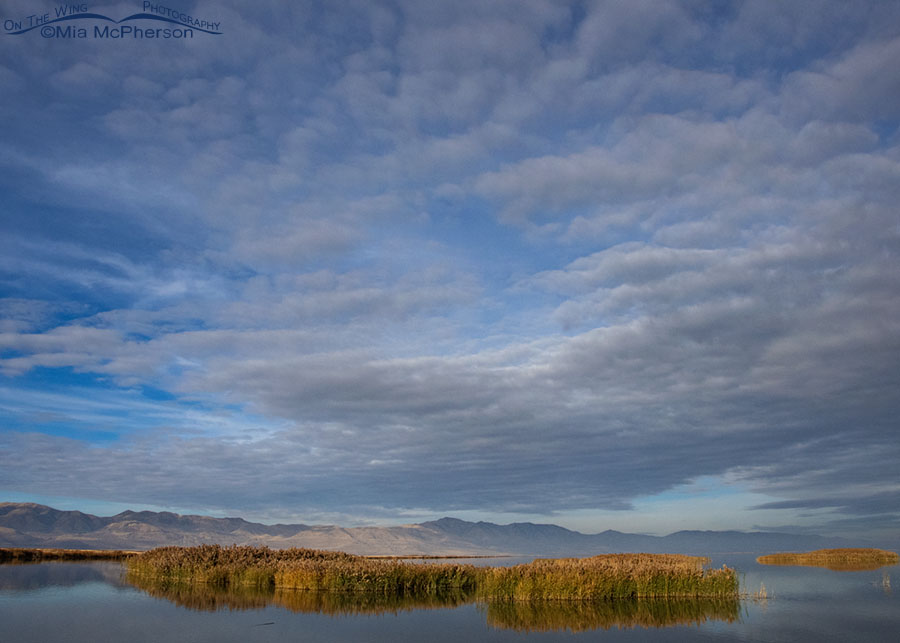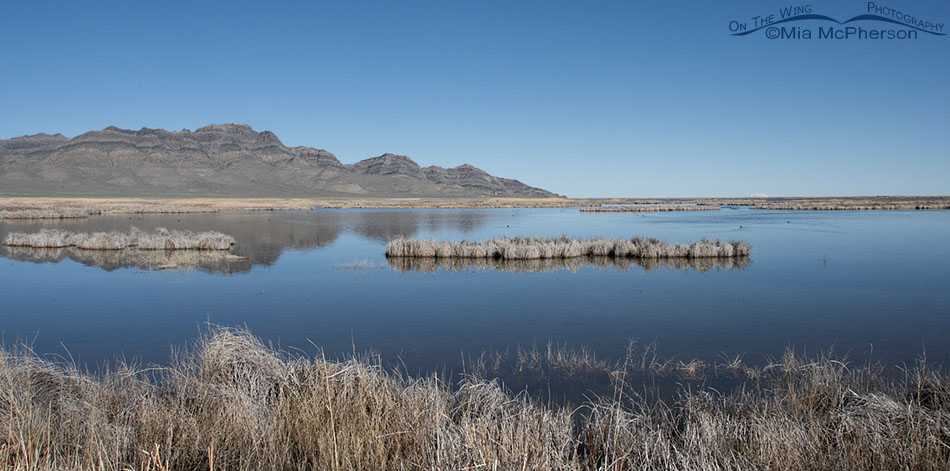Today is World Wetlands Day, and we need to protect and preserve our wetlands. Wetlands provide a wide range of ecological, economic, and social benefits.
 Fall visit to Bear River MBR
Fall visit to Bear River MBR
What Wetlands Do:
Biodiversity Support:
- Wetlands are home to a diverse array of plant and animal species, serving as crucial habitats for many organisms.
- They provide breeding grounds, nurseries, and feeding areas for various wildlife, including fish, amphibians, birds,mammals, and insects.
Water Filtration:
- Wetlands act as natural filters, trapping and removing pollutants from water. They help improve water quality by reducing the levels of nutrients, sediments, and contaminants.
Flood Control:
- Wetlands act as natural buffers against flooding by absorbing and storing excess water during periods of heavy rainfall or storm surges.
- They reduce the risk of downstream flooding and help regulate water flow.
Climate Regulation:
- Wetlands play a role in regulating local and global climate patterns by sequestering carbon and mitigating climate change.
- They act as carbon sinks, storing large amounts of carbon in their soils and vegetation.
Recreation and Aesthetics:
- Wetlands provide opportunities for outdoor recreational activities such as bird watching, fishing, hiking, and photography.
- They contribute to the aesthetic value of landscapes, offering scenic views and enhancing the overall beauty of an area.
Erosion Control:
- The vegetation in wetlands helps stabilize soil and prevent erosion, reducing the impact of storms and maintaining the integrity of coastlines and riverbanks.
Economic Benefits:
- Wetlands support various economic activities, including fisheries, agriculture, and forestry.
- They contribute to the economy by providing resources such as fish, timber, and non-timber forest products.
Water Supply:
- Wetlands play a crucial role in maintaining groundwater levels and sustaining water supplies for both human and natural systems.
- They help recharge aquifers and ensure a sustainable source of fresh water.
Educational and Scientific Value:
- Wetlands serve as living laboratories for scientific research and educational purposes, helping researchers and students understand ecosystems, biodiversity, and ecological processes.
Cultural Significance:
- Wetlands often hold cultural and spiritual importance for indigenous communities and local populations.
- They may be associated with traditional practices, folklore, and rituals, contributing to cultural identity.
Forests are the lungs of this planet, wetlands are the kidneys.
 Spring at Fish Springs National Wildlife Refuge in Utah
Spring at Fish Springs National Wildlife Refuge in Utah
Today, I am sharing images of two of our three National Wildlife Refuges in Utah: Bear River Migratory Bird Refuge and Fish Springs National Wildlife Refuge. Unfortunately, I don’t have many photos of our third refuge, Ouray National Wildlife Refuge, to share, but you can see some at the link I provided.
All three of Utah’s National Wildlife Refuges are critically important wetlands.
I’m extremely glad that they are federal and not state lands. You might wonder why I would write something like that.
It’s simple, really. The state of Utah has an abysmally poor record of protecting our environment. Our air quality is horrifically bad and the state? The state tells us not to drive. They don’t shut down the primary polluters, nope, business comes before people.
Another part of their historical and abysmally poor record includes their failure to protect the Great Salt Lake and the marshes and wetlands surrounding it.
If the three National Wildlife Refuges in Utah were under state control instead of federal they would suffer. About that, I have no doubt.
Several lawsuits have been filed against the state of Utah aimed at protecting the Great Salt Lake and the marshes and wetlands surrounding it. In 2023, five conservation groups, including the American Bird Conservancy, Center for Biological Diversity, and Earthjustice, filed a lawsuit against Utah’s natural resource leaders, arguing that the state’s efforts to protect the Great Salt Lake were “woefully inadequate”.
Today we are losing precious wetlands in the state to ‘inland ports’. Wetlands are being covered in fill dirt and huge warehousing areas are being built on them. All done without much public input, without adequate studies being done on the effects on wildlife or people, and all under the approval of the state appointed Utah Inland Port Authority.
Be aware, the state seems to have given the Utah Inland Port Authority carte blanche over where these inland ports are situated. They have known years ahead of time where these inland ports will go then drop that info on the public at the last moment for input.
Thus far, the Utah Inland Port Authority has completely ignored public input in every instance and have given the green light to every new proposed port.
The Utah Inland Port Authority Board did adopt a new wetlands compliance policy at its Nov. 6 board meeting. The policy allows for incentives that encourage developers to preserve wetland habitats impacted by future projects.
Encourages?
That is not a mandate, it is not enforceable, and it has no legal legs to stand on when it comes to protecting our wetlands. That is simply a government sanctioned, bait and switch tactic intended to appease, which absolutely does not protect our wetlands.
While the Great Salt Lake and the wetlands surrounding it were drying up and suffering, previous Governor Gary “Available Jones” Herbert took very little action to help the lake and wetlands. Indeed, he was more concerned about helping corporations and businesses. Current Governor Spencer Cox, Herbert’s former lackey, is much the same.
The government of Utah isn’t protecting our wetlands. The state is burying our wetlands in fill dirt and covering that with pavement and warehouses where more traffic will mean worse air along with the loss of critically important wetlands.
Utah gets an F for failure on environmental issues.
Mia
There are many articles about this situation in Utah, I honestly don’t have the time or energy to provide them all.
Great Salt Lake wetlands are the latest battleground with the Utah Inland Port – KUER


I really believe that our political leaders, from the Presidents on down, never wonder why the rivers keep flowing when it is not raining.
These beautiful and compelling landscape shots underscore your narrative about the wholesale destruction of the marshlands in Utah. I’m afraid such development will continue until we stop electing self-serving, greedy, elitists; which applies to many lawyers and all politicians. After-all, nothing speaks louder to an elected official, or an attorney, like a fistful of dollars.
Keep up the good fight Mia. You are not alone.
It’s important to name names in the industrial-scale dismantling of environmental protections.
“Supreme” Court decision gutting the Clean Water Act and wetlands protection, spearheaded by the infamous Samuel Alito, long sought by billionaire “developers.”
Thank you for the many updates you post. You have many, many valid points, but it doesn’t matter for the common people, the environment, wildlife, life itself, is of no importance when weighted against money. The claim of creating jobs (which I’m sure has been made in Utah) is entirely bogus. The jobs will be few and the cost to the rest of the living community both human and wild will be great.
Those who will benefit will not pay either the human or wildlife price. Enjoy what we have while we have it, every day.
I appreciate this post in particular. Literally sickening information.
What is the likelihood that Utah air quality will start to include more heavy metals and/or other harmful particles? Will cancer/other disease rates increase?
Mary, I believe it is highly probable that our air here will worsen, in fact doctors have spoken out against these inland ports because of their concerns that there will be a cost to the health of people living here, including the children the state says they love so much. The Utah Inland Port Authority ignores the doctors just like they have every other citizen speaking out against the ports.
Thank you for this thorough, accurate and informative post, Mia, and for constantly being a steward of nature.
Beth, thank you for your very kind comment. I feel an obligation as a nature lover, bird and wildlife photographer to speak for those who can’t speak for themselves.
What a great article. I can see myself quoting from it the next time I write a letter about the significance of wetlands.
Thank you Linda.
It’s not just in Utah or even just in USA. It’s the same here in Ontario & all over Canada. Nature seems to be taking a back seat to progress.
Liz, I am sorry to hear that about Ontario. That is so sad.